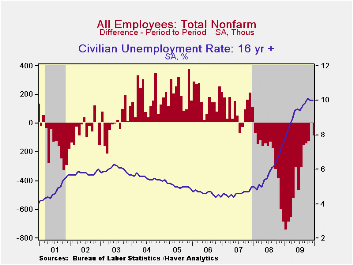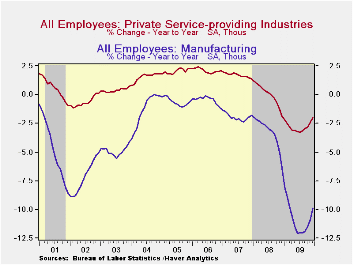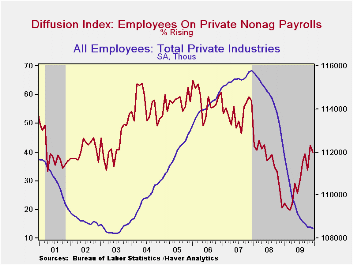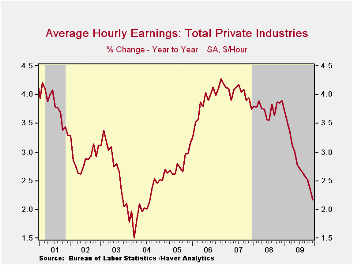 Global| Jan 08 2010
Global| Jan 08 2010U.S. December Payroll Decline Is Modest Disappointment; 2009 Is Weakest Year Since WWII
by:Tom Moeller
|in:Economy in Brief
Summary
The latest jobs report was disappointing for those who hoped for improved momentum in hiring, but diminishing weakness continued as the predominant message. The Bureau of Labor Statistics reported that nonfarm payrolls fell 85,000 [...]

The latest jobs report was disappointing for those who hoped for improved momentum in hiring, but diminishing weakness continued as the predominant message. The Bureau of Labor Statistics reported that nonfarm payrolls fell 85,000 last month after a 4,000 November increase (revised from -11,000) and a 127,000 October decline (revised from (-111,000). Together, the three-month average decline of 69,000 was the smallest of the recent recession. Consensus expectations has been for no change in December payrolls.
For 2009 as a whole, payrolls declined by 5.0 million, by far the worst decline since WWII. To emphasize the message of a weak labor market, the percentage term drop of 3.7% y/y also was the weakest of the postwar period, edging out a 3.6% decline in 1945.
 The payroll employment decline was accompanied by a stable
unemployment rate at 10.0%. Nevertheless, the latest was not far below
the postwar record of 10.8% reached late in 1982. For the year as a
whole the unemployment rate of 9.3% also was just below the record.
Last month, household sector employment fell a hard 589,000 (-3.8% y/y)
following a modest November increase. The decline was accompanied by a
661,000 shrinkage in the labor force (-1.0% y/y). This y/y decline was
the largest since early 1951. The number of individuals not in the
labor force rose a whopping 843,000 (4.2% y/y) with 6,306,000 (14.4%
y/y) who want a job now. (The household survey included modest
benchmark revisions.)
The payroll employment decline was accompanied by a stable
unemployment rate at 10.0%. Nevertheless, the latest was not far below
the postwar record of 10.8% reached late in 1982. For the year as a
whole the unemployment rate of 9.3% also was just below the record.
Last month, household sector employment fell a hard 589,000 (-3.8% y/y)
following a modest November increase. The decline was accompanied by a
661,000 shrinkage in the labor force (-1.0% y/y). This y/y decline was
the largest since early 1951. The number of individuals not in the
labor force rose a whopping 843,000 (4.2% y/y) with 6,306,000 (14.4%
y/y) who want a job now. (The household survey included modest
benchmark revisions.)
Elsewhere in the household survey of employment, the unemployment rate including marginally attached workers and those working part-time for economic reasons held near its high at 17.3%. For the year as a whole this measure stood at 16.3% versus 10.6% last year and 8.3% in 2007. The number of job losers on temporary layoff ticked up 10,000 (0.5% y/y) following huge declines during the prior two months. The number on permanent layoff fell by 275,000 (+57.2% y/y). Another measure compromising the employment picture was a rise in the median duration of unemployment to a record-high 20.5 weeks. The percent of those unemployed for more than 27 weeks rose to 39.8%.
In the establishment survey, the decline in service sector
hiring of 4,000 owed to a 21,000 drop (-0.3% y/y) in government hiring.
The number of private service sector jobs rose a modest 17,000 (-2.0%
y/y) after a larger November increase. For the year employment here
fell by 2.6 million (-2.8% y/y). Professional & business
services jobs rose 50,000 during December (-3.1% y/y) while
administrative & support jobs rose 42,400 (-3.9% y/y). That
included a 46,500 (-7.0% y/y) rise in temporary help services
employment which was the fifth consecutive monthly increase. Financial
activities employment rose 4,000 (-3.9% y/y) following declines that
steadily diminished earlier this year. Factory sector employment fell
again last month, by 27,000, which compares to -262,000 last January.
For the year as a whole factory sector jobs fell by 1.4 million and by
a record 10.7%. Construction employment fell another 53,000 and by
nearly one million for 2009 as a whole (-13.5% y/y), also by far the
record.
For the year employment here
fell by 2.6 million (-2.8% y/y). Professional & business
services jobs rose 50,000 during December (-3.1% y/y) while
administrative & support jobs rose 42,400 (-3.9% y/y). That
included a 46,500 (-7.0% y/y) rise in temporary help services
employment which was the fifth consecutive monthly increase. Financial
activities employment rose 4,000 (-3.9% y/y) following declines that
steadily diminished earlier this year. Factory sector employment fell
again last month, by 27,000, which compares to -262,000 last January.
For the year as a whole factory sector jobs fell by 1.4 million and by
a record 10.7%. Construction employment fell another 53,000 and by
nearly one million for 2009 as a whole (-13.5% y/y), also by far the
record.
The diffusion index for private nonfarm payrolls ticked lower to 40.0% last month but remained double the low of last March. For the factory sector, the index ticked up m/m to 39.8%. It had fallen to a low of 6.0% last January. These indexes are harbingers of future payroll levels.
 The length of the average workweek, often a harbinger of
future employment, held steady at 33.2 weeks, its highest level since
February. The workweek in the factory sector also held steady m/m at
40.4 weeks but the figure has been rising since a May low.
The length of the average workweek, often a harbinger of
future employment, held steady at 33.2 weeks, its highest level since
February. The workweek in the factory sector also held steady m/m at
40.4 weeks but the figure has been rising since a May low.
Average hourly earnings increased 0.2% after an upwardly revised November increase. The 2.9% gain for the year as a whole was its weakest since 2004. Earnings in the factory sector increased 0.3% and by 2.6% for the year. The durable sector's earnings rose 3.4% y/y while earnings in the private service sector rose a diminished 3.1%. Construction sector earnings rose 3.4% y/y though that was up from 1.2% growth in 2005.
The figures referenced above are available in Haver's USECON database. Additional detail can be found in the LABOR and in the EMPL databases.
| Employment: 000s | December | November | October | Y/Y | 2009 | 2008 | 2007 |
|---|---|---|---|---|---|---|---|
| Payroll Employment | -85 | 4 | -127 | -3.1% | -3.7 | -0.4% | 1.1% |
| Previous | -- | -11 | -111 | -- | -- | -- | -- |
| Manufacturing | -27 | -35 | -48 | -9.9 | -10.7 | -3.3% | -2.0% |
| Construction | -53 | -27 | -56 | -13.7 | -13.5 | -5.5% | -0.8% |
| Service Producing | -4 | 62 | -18 | -1.6 | -2.2 | 0.2% | 1.6% |
| Average Weekly Hours | 33.2 | 33.2 | 33.0 | 33.3 (Dec. '08) | 33.1 | 33.6 | 33.8 |
| Average Hourly Earnings | 0.2 | 0.2 | 0.3% | 2.2% | 2.9 | 3.8% | 4.0% |
| Unemployment Rate | 10.0% | 10.0% | 10.1% | 7.4% (Dec. '08) | 9.3% | 5.8% | 4.6% |
Tom Moeller
AuthorMore in Author Profile »Prior to joining Haver Analytics in 2000, Mr. Moeller worked as the Economist at Chancellor Capital Management from 1985 to 1999. There, he developed comprehensive economic forecasts and interpreted economic data for equity and fixed income portfolio managers. Also at Chancellor, Mr. Moeller worked as an equity analyst and was responsible for researching and rating companies in the economically sensitive automobile and housing industries for investment in Chancellor’s equity portfolio. Prior to joining Chancellor, Mr. Moeller was an Economist at Citibank from 1979 to 1984. He also analyzed pricing behavior in the metals industry for the Council on Wage and Price Stability in Washington, D.C. In 1999, Mr. Moeller received the award for most accurate forecast from the Forecasters' Club of New York. From 1990 to 1992 he was President of the New York Association for Business Economists. Mr. Moeller earned an M.B.A. in Finance from Fordham University, where he graduated in 1987. He holds a Bachelor of Arts in Economics from George Washington University.






